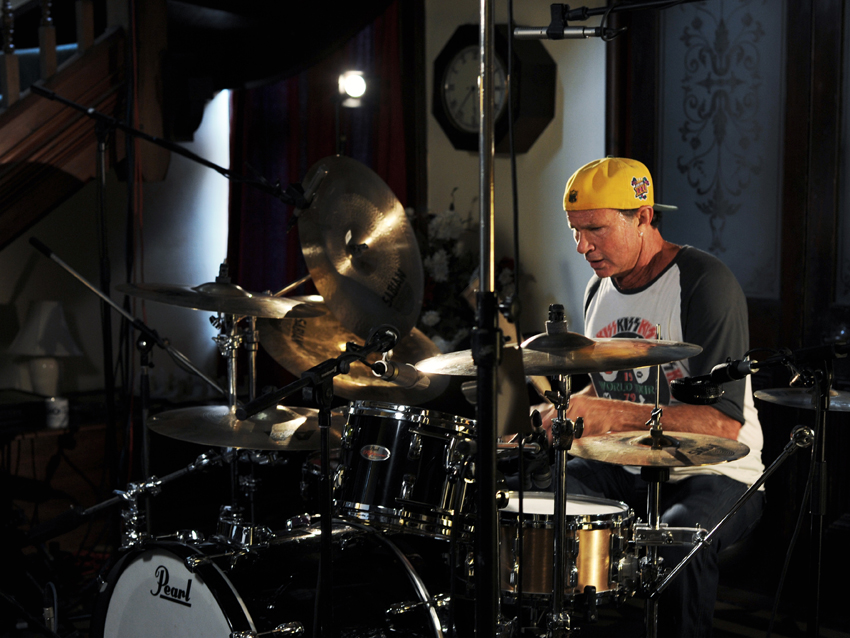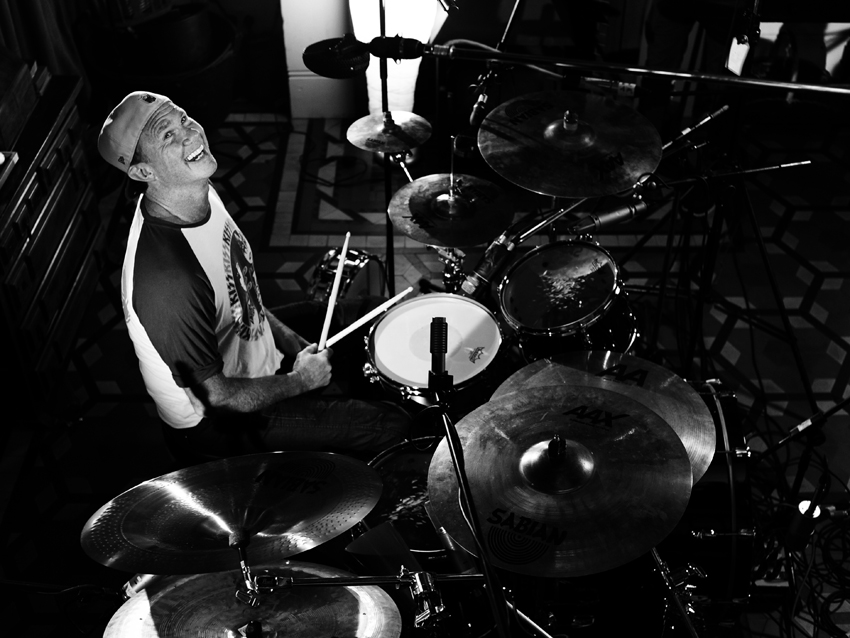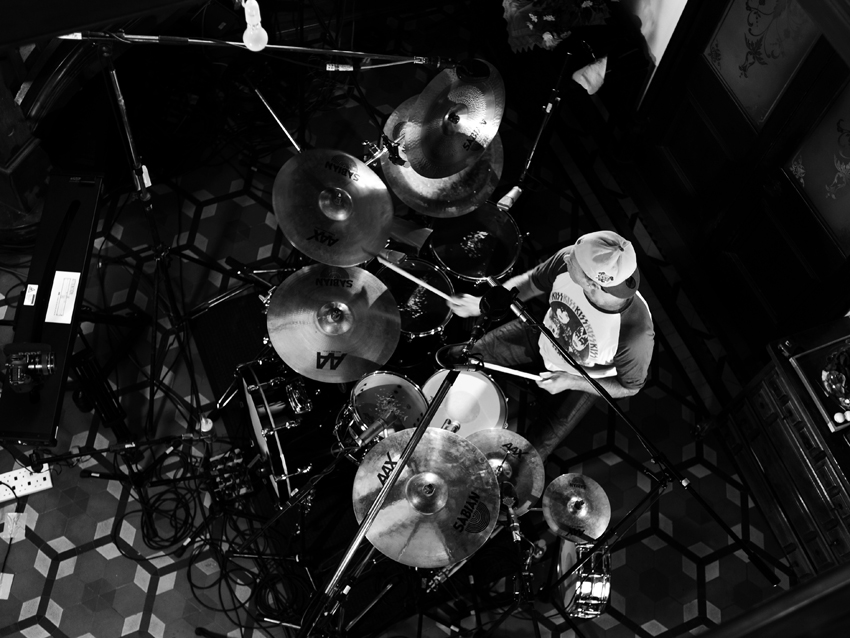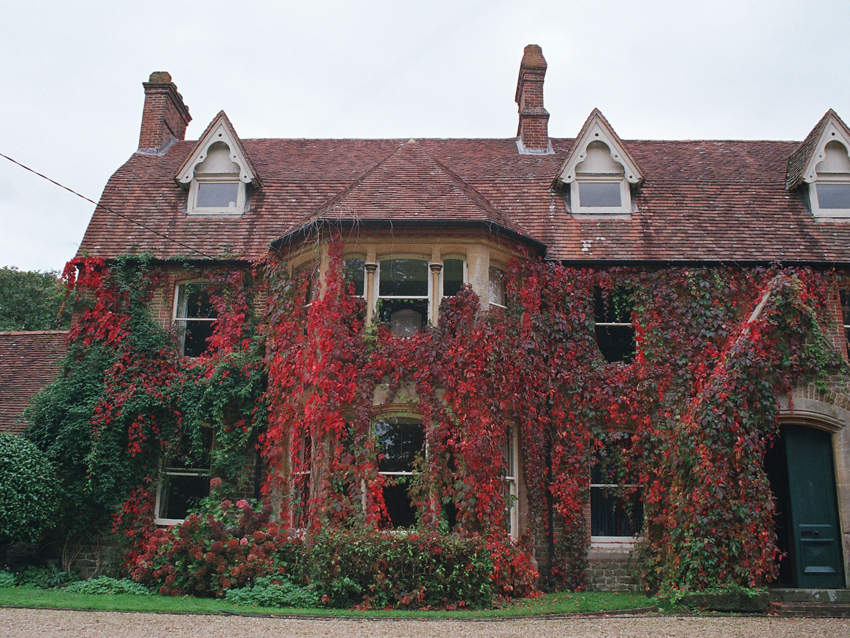
Chad Smith talks Led Zeppelin and The Grange
One could safely assume that Red Hot Chili Peppers drummer Chad Smith has realized a fair share of his adolescent rock-star fantasies. But one item on his proverbial bucket list, recording at Headley Grange (an 18th Century workhouse in Headley, Hampshire, England, recording home to a number of '60s and '70s UK bands, including Led Zeppelin), wasn't there at all because he simply didn't think it was possible.
"Some fantasy things are attainable one way or another," Smith says. "Let's say you want to record at Electric Lady, which I’d still love to do, well, if you have the money, you can record there. And on and on down the line. But for years and years, recording at Headley Grange just wasn’t on the table – they closed the place down to people in 1975. So I didn’t think about it. Then all of sudden, it was like, ‘Oh, my God, you mean I can?'"
Smith got his golden opportunity last fall when the folks at Spitfire Audio asked him, along with legendary Queen drummer Roger Taylor and modern session king Andy Gangadeen, to participate in the making of The Grange, a sample library and virtual instrument for Native Instruments' Kontakt Player that will allow musicians to add all three players to their own compositions. "It was a real honor to be a part of this project," Smith says. "For drummers and other musicians, they're getting a really creative and useful music tool, and for Roger, Andy and myself, we were able to step back into history in a way we never would have dreamed. Everybody wins."
Smith sat down with MusicRadar recently to talk about how his involvement with The Grange came about and what it was like to lay down grooves and beats in the same space as his hero, John Bonham.
Tell me how this whole thing started. When did you first hear about The Grange project?
“We were playing the Isle Of Wight Festival last year, and I was approached by Louise King [former editor of Rhythm magazine], who said, ‘I know these guys at Spitfire. They do these great sample libraries. I wonder if they can get you to go record at the Grange.’ I laughed and said, ‘You mean the Grange as in Led Zeppelin? Sure, that would be great’ – figuring it would never happen. It sounded amazing, but you know, nobody's been in there for 40 years.
“I talked to the Spitfire guys on the phone, and they were really cool – very enthusiastic and reverent – and they told me it was for real; they were getting the whole thing together. They knew the historical relevance of Headley Grange and what it meant to drumming, and to music in general. I got a great feeling from them and could tell that they wanted to do something really special, so I said, ‘Cool. I’m in.’”
Getting into Zeppelin as a kid, you undoubtedly read about Headley Grange in magazines, saw the name on album covers...
“Oh yeah, all of that. Back in the day, I scoured album covers. You've have the inner sleeves or the fold-outs with all the pictures and information, cool pictures. I would see Headley Grange listed, and I’d be like, ‘Wow, what is this place? Headley Grange, it must be amazing.’ You’re a teenager and this stuff seems so mythic.
“There’s so much information now about everything. Bands are so accessible, and you see them everywhere. Back then, you hardly ever saw Led Zeppelin; they were very inaccessible. They didn’t do television, so the only way you could see them was in concert, if you could get tickets. They were mythic and mysterious, and then you throw in the stories about drugs and groupies and Aleister Crowley and all that. To a little kid like me, that was big stuff. The whole Headley Grange thing was a key part of the legend.”

Setting back into history
It became a part of the Zeppelin's vibe, just like Abbey Road was for The Beatles. With both bands, you kind of personalized the room with the music.
“That’s right. The thing about Abbey Road, though, is that’s a proper studio. Same with Electric Lady and Hendrix – proper studio. Famous places, but they’re kind of different. If you have money, you can go and record there. You could not get into Headley Grange. It’s been a private residence for a long, long time, and they stopped opening it up to bands after Led Zeppelin did Physical Graffiti there. So that builds up the myth. Even if you had the dough, you couldn’t do it.
“To me, that’s what makes this so special, in addition to what you said, that there’s just something about the place. And certainly, when you talk about drums and drumming, it’s most iconic – that’s where John Bonham recorded When The Levee Breaks. As Roger Taylor says, ‘That’s the benchmark.’ I'm still pinching myself – I'm the first guy to record at Headley Grange since Bonham. I’m glad the owners told me that after I did it! [Laughs]
“I flew over from LA, and I was so excited the night before – I couldn’t sleep. I mean, Zeppelin is my favorite band, and Bonham is my favorite drummer. Those are my favorite records, basically. You walk in, and there at the entrance in the house, there’s the stairwell... I had read about that stairwell, and now I’m looking at it. It was pretty heavy.”
What did the Spitfire people want you to do specifically? What kind of plan or agenda did they run by you?
“It was kind of loose. They certainly did their homework for the recording end of things – I was doing the playing and they were capturing it. They talked to me and said, ‘We want you to do your thing.’ So at first, I was like, ‘Cool, man. I’ll bring in this old Ludwig 26-inch Led Zeppelin-Bonham kit.’ I was gonna play like that. But they said – really nicely – ‘Uh, no, that’s been done.’ [Laughs] They said, ‘ We’re not really going to need that. We want you to do your thing.’ It was funny – the fanboy in me was coming out.
“I played for five hours, all kinds of different grooves and beats. I played quiet, loud, slow, fast, whatever. I just laid it all out and ran out of things to do. [Laughs] They would encourage me – ‘Play this, play that.’ And, of course, I did all the sampling bits, playing each drum and cymbal, going from quiet to loud. When you get the package, there’s me playing all of these grooves. You can chop them up, slow ‘em down or speed ‘em up. You can use two mics, six mics – whatever you want.
“What was really cool and eye-opening was that they recorded it to two-inch tape. That makes such a difference. We’d done our last couple of records to tape and Pro Tools, and I think it’s really hard to tell the difference – Pro Tools has gotten so good. But this was night and day difference. There was so much depth and perspective on the tape, and there wasn’t that hiss and distortion that you can get sometimes. I attribute that to the room itself, because it has so much personality.”

The environment
Even though they told you they wanted you to be you, when you sit down at that kit and you’re in the same room that Bonham played in, does it make you play different – even a little?
“It affects you. Certainly when you sit down, you have to go [he imitates the When The Levee Breaks drum beat] – you have to! [Laughs] There’s no two ways about it. Acoustically, when you hear yourself playing in any space, it affects how you play; you react to what sounds good in that particular room. But then when you take into account what had been performed in this place all those years ago, yeah, that runs through your head."
From a sonic perspective, what is it about Headley Grange that renders such good drum sounds?
“It’s interesting. You go into the house, you see the stairwell, and then you notice that it’s not a really big space. You’d think from the Levee Breaks drum sound that it’d be this cavernous room, but it’s really quite small. It’s like this regular family-type foyer, and then the rooms spread off left and right. The stairs go up, but instead of being circular, they’re square, all the way up three floors. In the middle of that is a wooden beam with a chandelier to light up the rooms.
“I looked at that and went, ‘A-ha! The stairs and the beam are breaking up the sound.’ When you’re in a big flat room, it can be too hard sounding; when it breaks it up a bit, it can soften the sound. It was still hard wood floors – there was nothing really soft at all – and the stairs and that beam. It’s just one of those design things, a happy accident.
“With Headley Grange, because it’s that boomy, bigger, more resonant space, I thought the longer, slower grooves where notes can speak longer sounded better. To me, the faster stuff got a little lost. Not to say that it sounded bad, and on the Spitfire stuff you can take out the room, the close mics, and you’re still in that space – even close mics pick up the room. I did like the slower stuff because it really lent itself to what was so special about being in that stairwell. And it was more fun. [Laughs]
“You know, I talked to [producer/engineer] Andy Johns about this. He told me what everybody knows – Bonham brought in a new drum set, they set ‘em up, the guys went to the pub, and Andy put two mics down in the room, put Jimmy Page’s Italian echo thing on it, and boom, there’s the sound. Andy told me it was really simple and fast, and that was it.
“They recorded that for Levee Breaks, but when they recorded Misty Mountain Hop and Kashmir, they close-miked the kit for those songs. That’s the different sound. Levee Breaks is the two mics, and the other stuff is close-miked."

Personality counts
Sitting at the kit and playing in that room, is the reality differing wildly from the fantasy you had built up in your head for years?
“Oh yeah. You have this ‘Wow!... Headley Grange… It’s out in the middle of J.R. R. Tolkien-land or something.’ And it is in remote place – certainly it was more remote in the ‘70s, which is why Zeppelin wanted to go there, to get away from everything. But it’s just this regular house, and that makes it even cooler. It just goes to show you that you can do incredible things if you’ve got the right people with the right instruments and the right songs. It all worked.
“The place just has something unique, something you can't build. It has personality. Unlike most studios that they build now, where they want make things generic so that you can change it all around – that takes away personality. Or you have some acoustic expert come in to design the room so that it’s ‘perfect’ – again, no personality. What happened at Headley Grange was almost by happenstance. It wasn’t meant to happen, but it did.”
Were you on hand when Roger Taylor and Andy Gangadeen did their sessions?
“No, I wasn’t. I was the first one guy in. I played on a Friday, Roger played on Saturday and Andy did his thing on Sunday. I know Roger a little bit, so I left him a little note – ‘Have fun,’ that kind of thing. Roger is more of a contemporary of Bonham. I think Spitfire wanted somebody like him, and then I’m like the middle guy, and Andy’s more of the modern guy. A lot of people in the US don’t know him, but he’s incredible.”
Did you play any other Bonham licks when you were in that room – just to amuse yourself?
“I think I probably played Rock And Roll – they recorded that one there. Did I play The Rover? They did that one there, too. [He imitates the opening drum lick to The Rover.] That’s so cool! Oh, and another thing about the place – there was that fireplace where Robert Plant wrote the lyrics to Stairway To Heaven. It’s in the main room where they cut the tracks. I think he sat down and boom, wrote 80 percent of it right there. So, of course, I sat where he sat. Who wouldn’t? [Laughs] It was this once-in-a-lifetime thing. I was so pleased and was just floating around all day.
“I talked to the owners of the house. They were really cool – old couple, been married awhile. The wife had received the house as a wedding present from her grandmother in 1969. That’s some present, huh? [Laughs] But it was always meant to be a boarding house for people who worked the farm.
“Talking to couple was interesting. They didn’t know anything about rock bands. The wife said, ‘There was one guy… rode motorcycles… He tore up the front yard a lot and was drunk. He tried to ride a pig.’ I was thinking, ‘Yeah, sounds like Bonham.’ [Laughs] She said that only one or two guys were around for Led Zeppelin III; she wasn’t sure about IV. But she said when they came back for Physical Graffiti there were girls and it was a little crazy; they tried to burn the piano or the banister or something like that. ‘Stairway To Heaven – I know what that’s about,’ she said. ‘That’s when they walk upstairs to the girls.’ I was like, ‘I’m not sure about that, but that’s OK.’ She had her own take on it.”
For more information and to order The Grange, visit Spitfire Audio.
Joe is a freelance journalist who has, over the past few decades, interviewed hundreds of guitarists for Guitar World, Guitar Player, MusicRadar and Classic Rock. He is also a former editor of Guitar World, contributing writer for Guitar Aficionado and VP of A&R for Island Records. He’s an enthusiastic guitarist, but he’s nowhere near the likes of the people he interviews. Surprisingly, his skills are more suited to the drums. If you need a drummer for your Beatles tribute band, look him up.
